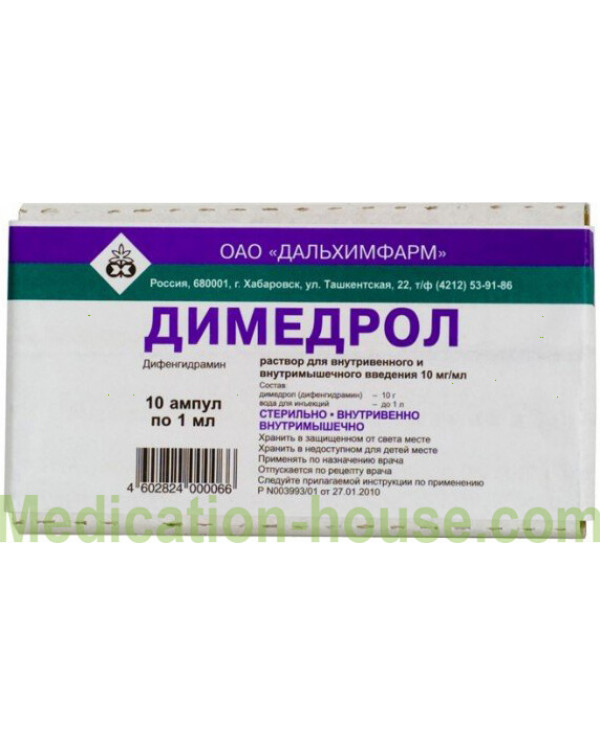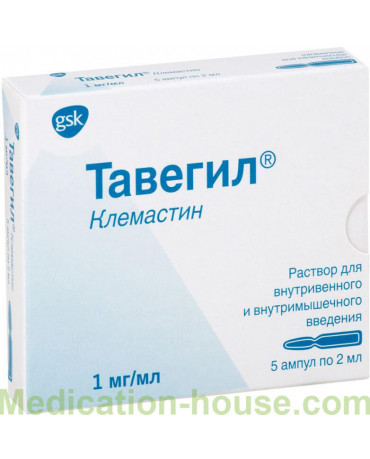Dimedrol instruction for use
You can buy Dimedrol on this page
Drug description
The drug is available in ampoules in the form of a solution for injection. 1 ml of the solution contains 10 mg of the active substance - diphenhydramine (diphenhydramine). Diphenhydraz in ampoules refers to the pharmacological group of drugs used to treat types of allergies, as well as sedatives and hypnotics. After intravenous, intramuscular administration, the drug quickly spreads through the body, passes through the blood-brain barrier and the placenta. The active substance of the drug is associated with plasma proteins at 98-99%. The active substance breaks down in the liver. The half-life (T1 / 2) of the drug is 1-4 hours. During the day, it is completely eliminated from the body mainly in the form of benzhydrol conjugated with glucuronic acid, and only in an insignificant amount - unchanged.
Dimedrol interaction with other drugs
Features of the interaction of the drug with other drugs and substances are as follows:
Diphenhydramine in ampoules enhances the effect of drugs that suppress the central nervous system. Therefore, the drug must be carefully taken with sleeping pills, neuroleptics, narcotic analgesics.
Dimedrol injection solution enhances the effect of anticholinergics and slows the motility of the digestive tract, which reduces the absorption (absorption) of drugs. If you take diphenhydramine simultaneously with indirect anticoagulants or paracetamol, the effectiveness of the latter will be significantly reduced.
When interacting with alcohol, Dimedrol increases its toxicity.
When is prescribed diphenhydramine (Dimedrol)?
The functional potential of the drug is quite extensive. It is used as an antihistamine, antiallergic, antiemetic, hypnotic, local anesthetic. In case of allergy, Dimedrol blocks histamine H1 receptors, thereby reducing the activity of histamine. As a result, the allergic reaction becomes less pronounced: spasms of the smooth muscles (the surface of the internal organs is covered with it) are stopped, and the capillary permeability increases. It also eliminates swelling of the tissues, itching and hyperemia (redness).
The role of antihistamine drugs
Diphenhydramine is used in bronchospasm caused by histamine liberators (tubocurarine, morphine, sombrevin), and to a lesser extent in allergic bronchospasm. In case of bronchial asthma, the drug is inactive and is used in combination with theophylline, ephedrine and other bronchodilators. Dimedrol is prescribed for the treatment of such diseases as: urticaria, hay fever, vasculitis, vasomotor rhinitis, angioedema, pruritic dermatosis, acute iridocyclitis, allergic conjunctivitis and other allergic complications from taking various medications, including antibiotics. The drug is also effective in the treatment of radiation sickness, chorea, sea and air sickness, vomiting. A solution of Dimedrol 1% for injection is prescribed to reduce the severity of adverse reactions during transfusion of blood and blood-substituting liquids, as well as other drugs. As a sedative and hypnotic, the drug is used independently and in combination with other hypnotics.
Dosage and administration
Dimedrol used intramuscularly and intravenously. Subcutaneously, the drug is not injected, as it irritates her. Intramuscular dose is 10-50 mg (1-5 ml of 1% solution). The intravenous dose is 20-50 mg dimedrol, introduced into 75-100 ml of isotonic sodium chloride solution. Maximum doses for adults with intramuscular administration: single - 0.05 g (5 ml of 1% solution), daily - 0.15 g (15 ml of 1% solution).
Some nuances
In hyperthyroidism, increased intraocular pressure, diseases of the cardiovascular system, in old age, Dimedrol must be taken very carefully. The use of the drug during the work of drivers of vehicles and people whose profession is associated with increased concentration of attention is excluded. During the period of treatment should avoid alcohol.
During the administration of the drug from the side of various functional systems, the following side effects are possible: Central nervous system and sensory organs: general weakness, fatigue, sedation, attention loss, dizziness, drowsiness, headache, poor coordination of movements, anxiety, increased excitability (especially in children ), irritability, nervousness, insomnia, euphoria, confusion, tremor, neuritis, convulsions, paresthesia; blurred vision, diplopia, acute labyrinthitis, tinnitus.
In patients with localized brain damage or epilepsy, it activates (even in low doses) convulsive discharges on the EEG and can provoke an epileptic seizure.
Cardiovascular system and blood: hypotension, palpitations, tachycardia, extrasystoles, agranulocytosis, thrombocytopenia, hemolytic anemia. Gastrointestinal system: dry mouth, short-term numbness of the oral mucosa, anorexia, nausea, epigastric distress, vomiting, diarrhea, constipation. Urogenital system: frequent and / or difficult urination, urinary retention, early menstruation.
Respiratory system: dry nose and throat, nasal congestion, thickening of bronchial secretions, chest tightness and shortness of breath. Allergic reactions: rash, urticaria, anaphylactic shock. Other symptoms include increased sweating, chills, and photosensitization.
Contraindications for Dimedrol
Diphenhydracidum is contraindicated in hypersensitivity, during pregnancy and breastfeeding, in infancy, in angle-closure glaucoma, prostate hypertrophy, stenotic gastric and duodenal ulcers, pyloroduodenal obstruction, bladder neck stenosis, pregnancy, bronchial ulcer, bronchial duodenal obstruction, stenosis of the bladder neck, pregnancy, bronchial ulcer, pyloroduodenal obstruction, bladder neck stenosis, pregnancy, bronchus
Terms of sell
You can buy Dimedrol without a prescription.



